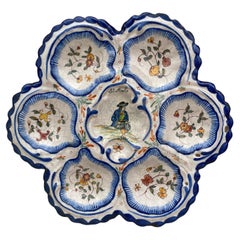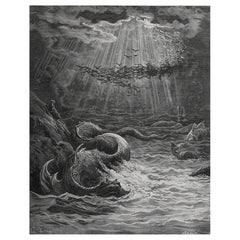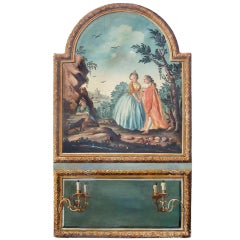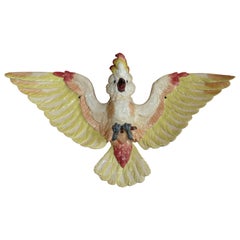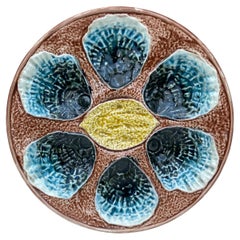19th Century Decorative Art
to
3,376
4,603
1,500
6,248
Height
to
Width
to
324
207
95
58
50
46
25
22
18
15
15
14
7
5
3
2
1,823
6,248
7,024
2,042
1,646
2,187
1,490
397
99
264
224
172
469
493
531
276
145
4,183
912
681
426
310
2,375
856
827
727
258
6,248
6,248
6,248
68
48
40
39
35
Period: 19th Century
19th Century French Faience Breton Oyster Plate Malicorne
Located in Austin, TX
Antique rare large French faience oyster plate, circa 1890 made by the manufacture of Malicorne with a Breton man on the center and flowers and butterflies.
Category
French Rustic Antique 19th Century Decorative Art
Materials
Faience
Large Original Antique Print By Gustave Doré From Milton's " Paradise Lost ".
By Gustave Doré
Located in St Annes, Lancashire
Sensational image by Gustave Dore
Originally an illustration for JohnMilton's " Paradise Lost "
Woodcut engraving
Published C.1880
Unframed.
Crease to top left corner
Free shi...
Category
English Romantic Antique 19th Century Decorative Art
Materials
Paper
Louis XVI Style Trumeau Panel with Trompe L'oeil Mirror Panel
Located in Nashville, TN
Possibly late 18th century but most likely 19th century painted arched painted panel. Either a panel intended for a trumeau or to be inset into wall boiserie as a trumeau. The upper ...
Category
French Louis XVI Antique 19th Century Decorative Art
Materials
Canvas, Paint
$1,440 Sale Price
20% Off
Oversize Majolica Parrot Applique Sarreguemines, circa 1870
Located in Austin, TX
Rare oversize colorful Majolica wall applique signed Sarreguemines Majolica, circa 1870.
Measures: 44"W
25" H
Category
French Victorian Antique 19th Century Decorative Art
Materials
Majolica
19th Century French Majolica Oyster Plate
Located in Austin, TX
19th century French Majolica Oyster plate unsigned, with a lemon on the center.
Category
French French Provincial Antique 19th Century Decorative Art
Materials
Ceramic
MARRIAGE OF CUPID AND PSYCHE OIL ON CANVAS in Giltwood Kent Style Frame
Located in Reepham, GB
This oil on canvas is a meticulous reproduction of Giovanni Francesco Penni’s “Marriage of Cupid and Psyche” fresco (1517-18) from Villa Farnesina, Rome. Framed in an intricately car...
Category
Antique 19th Century Decorative Art
Materials
Paint
Pl. 90 Antique Print of XVIIIth Century Ornaments by Racinet (c.1890)
Located in Langweer, NL
Antique print titled 'XVIIIth Century - XVIIIe Siecle - XVIIItes et Jahrhundert'. Chromolithograph of XVIIIth Century ornaments and decorative arts. This print originates from 'l'Orn...
Category
Antique 19th Century Decorative Art
Materials
Paper
$139 Sale Price
20% Off
Charcoal Drawing on Blue Paper By William Wardlaw Laing, C.1880
Located in St Annes, Lancashire
Wonderful charcoal portrait of a girl.
By a very good victorian artist, William Wardlaw Laing*
Sitter unknown.
Signed lower left
Presented in an antique bleached tropical hardw...
Category
English Victorian Antique 19th Century Decorative Art
Materials
Paper, Wood
Original Antique Print of Beetles, 1847, 'Unframed'
Located in St Annes, Lancashire
Great image of beetles.
Unframed. It gives you the option of perhaps making a set up using your own choice of frames.
Lithograph after Cpt. brown with original color.
Published, 1...
Category
English Folk Art Antique 19th Century Decorative Art
Materials
Paper
Antique Chromolithograph of Mambrino, Grey Thoroughbred Racehorse
Located in Langweer, NL
Antique print titled 'Mambrino bred by Lord Grosvenor'. Antique print of Mambrino, grey thoroughbred racehorse, foaled in 1768, bred by John Atkinson of Scholes at whose death became the property of Richard Grosvenor...
Category
Antique 19th Century Decorative Art
Materials
Paper
$316 Sale Price
20% Off
Wooden Micro Carving Plaque by Johann Rint ca. 1880
Located in Berghuelen, DE
Wooden Micro Carving Plaque by Johann Rint ca. 1880
A small wall plaque with detailed relief carvings worked out of linden wood by Johann Rint ca. 1880....
Category
Austrian Black Forest Antique 19th Century Decorative Art
Materials
Wood
French Framed Oil on Canvas Still-Life Painting Signed Morin, Depicting Fruits
By M. Morin
Located in Atlanta, GA
A French framed oil on canvas still-life painting from the 19th century depicting fruits, signed Morin. Created in France during the 19th century, this oil on canvas painting features mouth-watering cherries and prunes displayed in wicker baskets and flanked with a copper strainer...
Category
French Antique 19th Century Decorative Art
Materials
Canvas, Giltwood
African Vintage Shield, Tribal Wall Art, SONGYE SHIELD, Congo, Mid 20th Century
Located in Odense, DK
The Songye Shield is a striking example of African tribal art from the Congo, dating back to the mid-20th century. This shield, traditionally used by the Songye people for protection...
Category
Congolese Primitive Antique 19th Century Decorative Art
Materials
Wood
Framed Antique Suzani Fragment, 19th C.
Located in Istanbul, TR
First the fragment has been hand backed on a linen fabric, then stretched over a wooden stretcher and finished with a wooden frame.
Late 19th C. Uzbekistan
Ready to go on a wall.
Fr...
Category
Uzbek Suzani Antique 19th Century Decorative Art
Materials
Silk
19th Century French Rustic Faience Plate Desvres Gabriel Emile Fourmaintraux
Located in Austin, TX
19th Century French Rustic Faience Plate Desvres signed Gabriel Emile Fourmaintraux.
Painting of flowers blue and olive colors.
Category
French French Provincial Antique 19th Century Decorative Art
Materials
Faience
Original Antique Print of a Bee-Eater, 1847 'Unframed'
Located in St Annes, Lancashire
Great image of a bee-eater
Unframed. It gives you the option of perhaps making a set up using your own choice of frames.
Lithograph after Cpt. brown with original hand color.
Publ...
Category
English Folk Art Antique 19th Century Decorative Art
Materials
Paper
Antique Steel Engraved Print showing Natives of Michoacan, Mexico
Located in Langweer, NL
Antique print titled 'Tracht der Indianer von Mechoacon' Original antique steel engraving showing the costumes of natives of Michoacan, Mexico...
Category
Antique 19th Century Decorative Art
Materials
Paper
$363 Sale Price
20% Off
French Majolica Bird & Flower Plate, Circa 1890
Located in Austin, TX
French Majolica bird & flower plate, Circa 1890.
Category
French Rustic Antique 19th Century Decorative Art
Materials
Ceramic, Faience
Antique Print of a Persian Man in Traditional Clothing and with a Dagger, 1843
Located in Langweer, NL
Antique costume print titled 'Perse - Homme du Peuple'. Original antique print of a Persian man. This print originates from 'Moeurs, usages et costumes de ...
Category
Antique 19th Century Decorative Art
Materials
Paper
$130 Sale Price
20% Off
French Blue Majolica Plate with Yellow Flowers Circa 1890
Located in Austin, TX
French Blue Majolica Plate with Yellow Flowers Circa 1890.
Category
French Rustic Antique 19th Century Decorative Art
Materials
Ceramic
Original Antique Illuminated Print of St George. C.1880
Located in St Annes, Lancashire
Wonderful print of St George
Illuminated Chromolithograph
Published circa 1880
Unframed.
Free shipping
The measurement is the paper size
Category
English Gothic Antique 19th Century Decorative Art
Materials
Paper
Original Antique Print After Rembrandt, the Raising of Lazarus, Dated 1842
Located in St Annes, Lancashire
Wonderful image after Rembrandt
Fine Steel engraving.
Published by Fisher, London, Dated 1842
Unframed.
Category
English Baroque Antique 19th Century Decorative Art
Materials
Paper
Original Antique Illuminated Print of St Agatha. C.1880
Located in St Annes, Lancashire
Wonderful print of St Agatha
Illuminated Chromolithograph
Published circa 1880
Unframed.
Free shipping
The measurement is the paper size
Category
English Gothic Antique 19th Century Decorative Art
Materials
Paper
Original Antique Illuminated Print of St Peter. C.1880
Located in St Annes, Lancashire
Wonderful print of St Peter
Illuminated Chromolithograph
Published circa 1880
Unframed.
Free shipping
The measurement is the paper size
Category
English Gothic Antique 19th Century Decorative Art
Materials
Paper
Large Majolica Leaves Plate Wasmuel, circa 1890
Located in Austin, TX
Rare large Majolica leaves plate Wasmuel, Circa 1890.
Measure: 10 inches diameter.
Category
Belgian Rustic Antique 19th Century Decorative Art
Materials
Ceramic
Set of 3 Antique Bird Prints, Blackcap, Whitethroat, Turtledove, circa 1850
Located in Langweer, NL
Set of three antique bird prints titled 'La Fauvette à tête noire - La Fauvette Grise' - 'Pigeons - La Tourterelle' - 'La Mésange bleue - La Mésange huppée - Le Grimpereau'. These li...
Category
Antique 19th Century Decorative Art
Materials
Paper
$279 Sale Price / set
20% Off
Professionally Framed Antique Suzani Fragment , Tajikstan, Central Asia
Located in Istanbul, TR
The suzani fragment on the frame is from a 19th C. Suzani. It is hand backed on linen and streched over a strecher and finish with a wooden frame.
Ready to go on any wall.
The item ...
Category
Tajikistani Suzani Antique 19th Century Decorative Art
Materials
Silk
Zabihi Collection Antique Persian Soft Red Bidjar Rug
Located in New York, NY
a soft abrash red color late 19th Century, large-scale pattern Persian Bidjar Carpet
Details
rug no. j3900
size 9' 6" x 12' (290 x 366 cm
Category
Persian American Colonial Antique 19th Century Decorative Art
Materials
Wool
Original Antique Print of a Blue Tit, circa 1880, 'Unframed'
Located in St Annes, Lancashire
Great image of a Blue Tit
Unframed. It gives you the option of perhaps making a set up using your own choice of frames.
Lithograph after Alexander Francis Lydon.
Original color
P...
Category
English Folk Art Antique 19th Century Decorative Art
Materials
Paper
19th Century French Majolica Plate
By Orchies
Located in Austin, TX
Lovely colorful French Majolica plate with flowers and acanthus leaves Orchies, circa 1890.
Category
French French Provincial Antique 19th Century Decorative Art
Materials
Ceramic
19th Century Green Majolica Oyster Plate
Located in Austin, TX
Colorful French Majolica green oyster plate with stylized leaves, circa 1890.
Very rare color.
Category
French Rustic Antique 19th Century Decorative Art
Materials
Ceramic
Original Antique Greek Mythology Print After J.M.W Turner. C.1850
Located in St Annes, Lancashire
Great image after J.M.W Turner
Fine steel engraving
Published by Virtue, C.1850
Unframed.
Free shipping
Category
English Classical Greek Antique 19th Century Decorative Art
Materials
Paper
French Majolica Bird & Cherries Plate Sarreguemines, circa 1880
Located in Austin, TX
French Majolica bird with cherries plate Sarreguemines, circa 1880.
Category
French Rustic Antique 19th Century Decorative Art
Materials
Ceramic
French Majolica Asparagus Plate Onnaing, circa 1890
By Onnaing
Located in Austin, TX
French Majolica asparagus plate Onnaing, circa 1890.
Category
French Country Antique 19th Century Decorative Art
Materials
Ceramic
Original Antique Architectural Print by John Ruskin, circa 1880, Venice
By John Ruskin
Located in St Annes, Lancashire
Wonderful Gothic architectural print.
Window from Ca Foscari, Venice
Steel engraving by R.P. Cuff after the original drawing by John Ruskin
Published, circa 1880
On wove ...
Category
English Gothic Revival Antique 19th Century Decorative Art
Materials
Paper
19th Century Italian Grand Tour Set of Portrait Medals of The 12 Roman Emperors
Located in Stamford, CT
Wonderful mounted and framed 19th century Italian Grand Tour set of silvered bronze portrait medallions of The 12 Roman Emperors surrounding 3 larger medals, one showing the Battle o...
Category
Italian Grand Tour Antique 19th Century Decorative Art
Materials
Bronze
19th Century French Painted Paper Fan with Box
Located in Brea, CA
This ornate, antique paper hand fan was crafted in France, circa 1850. the one side showing a candlelit interior where Gallant scene on the reverse with a box but no glass of box. Se...
Category
French French Provincial Antique 19th Century Decorative Art
Materials
Paper
Original Antique Print of Alexandria, Egypt, circa 1850
Located in St Annes, Lancashire
Wonderful image of Alexandria
Fine steel engraving after W.H Bartlett
Published circa 1850
Unframed.
Free shipping
Category
English Moorish Antique 19th Century Decorative Art
Materials
Paper
Large Wool and Glass Beads Needlework Panel of Mary Queen of Scots
Located in London, GB
Large wool and glass beads needlework panel of Mary Queen of Scots
Scottish, circa 1870
Panel: Height 107cm, width 150cm, depth 2cm
Frame: Height 155cm, width 187cm, depth 20cm
Handmade by a group of Scottish sisters from the Stark family around 1870, this needlework picture panel portrays an important scene from British history.
Mary Queen of Scots is seen weeping over the dying George Douglas of Lochleven at the Battle of Langside in which she was defeated. This event was significant because it let to Mary’s imprisonment in England under the command of Elizabeth I in 1568.
The piece is crafted in polychrome wool with detailing such as jewellery or shadows are highlighted in shining glass beads.
Charles Landseer’s painting...
Category
Scottish Victorian Antique 19th Century Decorative Art
Materials
Other
French Green Majolica Acanthus Leaves Plate, circa 1880
Located in Austin, TX
French Majolica acanthus leaves plates, circa 1880.
Category
French Rustic Antique 19th Century Decorative Art
Materials
Ceramic
Antique Bronze English Church Bell
Located in Wormelow, Herefordshire
An antique bronze bell reclaimed from an English church marked to F Baker.
Dating to circa 1830, this historic bronze has a beautiful patina complimented by its original wrought iro...
Category
English Georgian Antique 19th Century Decorative Art
Materials
Metal, Bronze
French Majolica Daisy Plate Orchies, circa 1890
By Orchies
Located in Austin, TX
French Majolica daisy plate Orchies unsigned, circa 1890.
Category
French Art Nouveau Antique 19th Century Decorative Art
Materials
Ceramic
Framed Antique Ottoman Embroidery Fragment , Late 19th Century.
Located in Istanbul, TR
First the fragment has been hand backed on a linen fabric, then stretched over a wooden stretcher and finished with a wooden frame.
Late 19th Century. Turkey
Ready to go on a wall.
...
Category
Turkish Folk Art Antique 19th Century Decorative Art
Materials
Silk
Framed Antique Ottoman Embroidery Fragment , Late 19th Century.
Located in Istanbul, TR
First the fragment has been hand backed on a linen fabric, then stretched over a wooden stretcher and finished with a wooden frame.
Late 19th Century. Turkey
Ready to go on a wall.
...
Category
Turkish Folk Art Antique 19th Century Decorative Art
Materials
Silk
Framed Antique Moroccan Embroidery Fragment , Late 19th Century.
Located in Istanbul, TR
First the fragment has been hand backed on a linen fabric, then stretched over a wooden stretcher and finished with a wooden frame.
Late 19th Century. Morocco
Ready to go on a wall....
Category
Moroccan Folk Art Antique 19th Century Decorative Art
Materials
Silk
Framed Antique Moroccan Embroidery Fragment , Late 19th Century.
Located in Istanbul, TR
First the fragment has been hand backed on a linen fabric, then stretched over a wooden stretcher and finished with a wooden frame.
Late 19th Century. Morocco
Ready to go on a wall....
Category
Moroccan Folk Art Antique 19th Century Decorative Art
Materials
Silk
Woven Textile Fragment. East European. 19th Century
Located in St Annes, Lancashire
Lovely textile sample
Fabulous colours
Great piece of folk art.
Likely to be of East European origin. Possibly Balkan.
In new white painted box fra...
Category
Balkan Folk Art Antique 19th Century Decorative Art
Materials
Wool, Cotton
Antique Print of a Chinese Man 'Mandarin' by Wahlen, '1843'
Located in Langweer, NL
Antique costume print titled 'Mandarin Chinois'. Original antique print of a Chinese man (Mandarin). This print originates from 'Moeurs, usages et costumes de tous les peuples du mon...
Category
Antique 19th Century Decorative Art
Materials
Paper
$93 Sale Price
20% Off
Original Antique Print of Cairo, Egypt. Dated 1809
Located in St Annes, Lancashire
Wonderful image of Cairo
Fine copper-plate engraving
Published by Sherwood & Co.
Dated 1809
Unframed.
Free shipping
Category
English Moorish Antique 19th Century Decorative Art
Materials
Paper
Original Antique Illuminated Print of St Bruno of Cologne. C.1880
Located in St Annes, Lancashire
Wonderful print of St Bruno of Cologne
Illuminated Chromolithograph
Published circa 1880
Unframed.
Free shipping
The measurement is the paper size
Category
English Gothic Antique 19th Century Decorative Art
Materials
Paper
Pl. 61 Antique Print of Renaissance Ornaments by Racinet, 'circa 1890'
Located in Langweer, NL
Antique print titled 'Renaissance - Renaissance - Renaissance'. Chromolithograph of Renaissance ornaments and decorative arts. This print originates from 'l'Ornement Polychrome' by A...
Category
Antique 19th Century Decorative Art
Materials
Paper
$139 Sale Price
20% Off
Italian Neoclassic Walnut Framed Biribissi Game, 2nd quarter 19th century
Located in Atlanta, GA
this game, with its origin in the Renaissance, is a lottery game with cards being drawn that correspond to the characters and objects on the board. with the advent of printing in th...
Category
Italian Neoclassical Antique 19th Century Decorative Art
Materials
Walnut
Pair of Massive Framed Italian Majolica Chargers, circa 1880
Located in New York, NY
Finely painted in an Italian palette with mythological and Roman battle scenes, each border rim painted with yellow enamel. With a large carved ebony...
Category
Italian Antique 19th Century Decorative Art
Materials
Majolica
English Majolica Vine & Strawberries Plate, circa 1880
Located in Austin, TX
English Majolica vine & strawberries plate, circa 1880.
Very rare color.
Hairline.
Category
English Victorian Antique 19th Century Decorative Art
Materials
Ceramic, Faience, Majolica
Antique Hand-Colored Engraving of a Lady from Denmark, 1805
Located in Langweer, NL
Antique costume print titled 'Dänische Dame - Dame de Qualité de Dannemarck 1626'. This print depicts a Lady from Denmark. Originates from a rare costume book titled 'Sammlung von Tr...
Category
Antique 19th Century Decorative Art
Materials
Paper
$260 Sale Price
20% Off
Majolica Asparagus Plate Clairefontaine, circa 1880
Located in Austin, TX
Majolica asparagus plate signed Clairefontaine, circa 1880.
Diameter / 9.5 inches.
Category
French Country Antique 19th Century Decorative Art
Materials
Ceramic, Faience, Majolica
Original Antique Religion Print Depicting God's Covenant with Abraham, C.1850
Located in Langweer, NL
Large antique print with two religious engravings. The upper image depicts the The Meeting between Abraham and Melchizedek. The lower image depicts God's Covenant with Abraham. This print originates from a work illustrating the complete series of Vatican frescos painted...
Category
Antique 19th Century Decorative Art
Materials
Paper
$521 Sale Price
30% Off
French Majolica Dish Leaf, Circa 1890
Located in Austin, TX
French Majolica dish reticulated leaf, Circa 1890.
Category
French Rustic Antique 19th Century Decorative Art
Materials
Ceramic
Late 19th Century Oil Painting "Peeling Apples" by Crisson, circa 1899
Located in San Francisco, CA
Late 19th century oil painting "Peeling Apples" by Crisson circa 1899
Original oil on canvas. A woman peels apples while her friend ...
Category
American Antique 19th Century Decorative Art
Materials
Canvas
Large Majolica Morning Glory Plate Wasmuel Circa 1890
Located in Austin, TX
Large Majolica Morning Glory plate Wasmuel Circa 1890.
9.5" diameter.
Category
Belgian Rustic Antique 19th Century Decorative Art
Materials
Ceramic
Read More
At Colonial Williamsburg, Everything Old Is New Again
With the help of a new director, the Virginia institution's folk art and decorative arts museums are undergoing extensive upgrades.
New York’s Hirschl & Adler Showcases the American Workmanship and Design Panache of Neoclassical Treasures
The gallery's latest exhibition proves that museum-quality pieces entice and inspire, whether in traditional or more modern interiors.
Recently Viewed
View AllMore Ways To Browse
Greyhound Dog Figure
Guilloche Cigarette Case
Guilloche Pill Box
Gustavian Bedside
Guzzini Ice
Halston Furniture
Hand Carved Wooden Buddha Head
Henredon Cherry
Henredon French Regency
Hermes Longchamp
Horse Trophy Cup
King Provincial Bed
Limoges Teapot
Mcm Glass Vase
Mjolby Intarsia
Murano Turtle
Printers Drawers
Rustic Bar Cart
